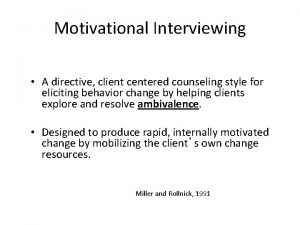Module 5 Motivational Interviewing as a Counseling Style







- Slides: 7

Module 5 Motivational Interviewing as a Counseling Style

Assumptions of Motivational Interviewing n n n Ambivalence is normal and an obstacle. Ambivalence can be resolved. Collaborative partnership—each has expertise. An empathic, supportive, yet directive, counseling style facilitates change. Direct argument/aggressive confrontation may increase defensiveness, reduce likelihood of change. TIP 35: Enhancing Motivation for Change Inservice Training OH OH#5 -2 #4– 2

Express Empathy n n The key component of expressing empathy is reflective listening. Imposing direction and judgment rather than listening reflectively creates barriers that impair therapeutic relationship. TIP 35: Enhancing Motivation for Change Inservice Training OH OH#5 -3 #4– 3

Develop Discrepancy n n n Clinicians help clients recognize discrepancies by using carefully chosen, strategic reflecting. Clients’ cultural background affects their perceptions of discrepancy. Clinicians must have a good understanding of the clients’ cultural values. TIP 35: Enhancing Motivation for Change Inservice Training OH OH#5 -4 #4– 4

Avoid Argument n n Power struggles between clinician and client do not enhance motivation for change. When it is the client, not the clinician, who voices arguments for change, progress can be made. TIP 35: Enhancing Motivation for Change Inservice Training OH OH#5 -5 #4– 5

Support Self-Efficacy n n n Communicate belief in the client’s capacity Talk about how others in similar situations have changed Provide opportunities for other clients to act as role models Provide credible, understandable, accurate information Provide information about tools for recovery in a way that instills hope in the client Break the change process down into achievable small steps TIP 35: Enhancing Motivation for Change Inservice Training OH OH#5 -6 #4– 6

Roll With Resistance is a signal that the clinician needs to change direction with or listen more carefully to the client. TIP 35: Enhancing Motivation for Change Inservice Training OH OH#5 -7 #4– 7













